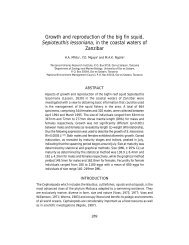gpa_east_africa_case.. - GRID Africa GeoPortal - UNEP
gpa_east_africa_case.. - GRID Africa GeoPortal - UNEP
gpa_east_africa_case.. - GRID Africa GeoPortal - UNEP
Create successful ePaper yourself
Turn your PDF publications into a flip-book with our unique Google optimized e-Paper software.
Pollution loadsThe following table summarises water pollution loads generated by various sources on Mahéisland.Water pollution generated in Mahé (tonnes)BOD 5 SSFisheries industry 97.42 59.44Other foods industry 3 393.10 17 345.74Manufacturing industry 1.64 2.78Urban settlement and construction 0.54 0.74Natural processes 1.25 12.91Total 3 493.95 17421.61Source: Shah, 1997TypesThe greater Beau Vallon area has a total population equivalent of some 7,300, with sewageeffluent discharges estimated at 900 kl/day. There is strong evidence of significant faecalcontamination in the rivers, largely attributed to diffuse pollution caused by ineffective andinappropriate sewerage arrangements (Shah, 1997). Coastal and human health in the area isvery much linked to adequate treatment of wastewater; significant pollution would adverselyaffect all socio-economy activities.Pollution sources in the study area can be categorised as follows:• Individual households with traditional socio-economic activities including the keeping ofdomestic animals• Tourism industrySourcesAccording to a recent census, approximately 80% of the houses in the Beau Vallon Bay areaare served by potable water network. In the absence of collective sewerage infrastructures,the existing dwellings are equipped with simple septic tanks followed by a cesspool or a drypitfrom which the overflow waters seep into the ground and rivers. Likewise, 20% of thehouses are reported to be without modern lavatories, latrines in the best of <strong>case</strong>s, andsometimes without any equipment, and pollutants are spread directly on the ground. It iscommon for households to rear pigs and chicken close to their homes. Animal slurries aremore destructive than that of humans. According to a survey made at Beau Vallon, quite anumber of households, even those living in flats, have pig sties with slurry pits and outfallsnear rivers (Payet, 1996). There are three major hotels in the study area with seweragetreatment facilities: Berjaya Beau Vallon, Coral Strand and Le Meridien Fisherman’s Covewith a total of 333 rooms (1,236 population equivalent). Hotel establishments over a certainsize for instance are required by law to install centralised wastewater treatment systems priorto disposing wastewater into the environment.Virtually all tourism establishments are located on the coastal fronting on the beach. Theproximity to marine waters therefore exacerbates the wastewater impact of tourismestablishments. The package treatment plants of the larger hotels are not functioningadequately. All the other establishments use septic tank systems which notoriously leak(Shah, 1998). The 1996 SOGREH Report on the Beau Vallon Bay sewerage project statesthat the pollution in Beau Vallon Bay, is caused by: tourism sector of the area 1/6 shares,domestic sector of the area 5/6 shares.NameBerjaya Beau Vallon BayHotelSources of sewage from hotels and guest houses in Beau VallonSeweragePresent Impact Potential ImpactTreatmentAS; outlet in road Algal growth,side drainodourWater quality and coraldeteriorationCoral Strand HotelSun Resorts B.V. Prop.AS; 150 m. seaoutfallSTAlgal growth,nutrientoverloadingWater quality and coraldeteriorationFinal Draft Report – Cost Benefit Case StudiesGPA Strategic Action Plan on Sewage, October, 200091



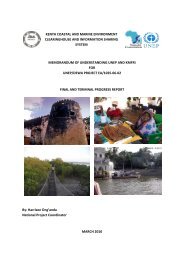
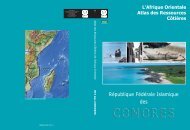
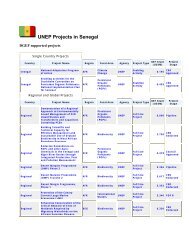

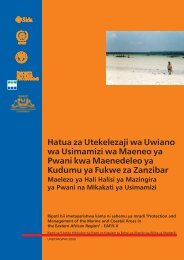
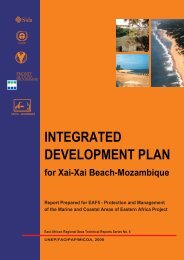
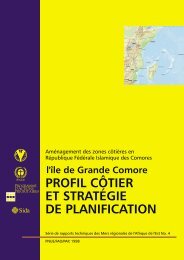
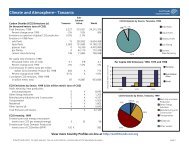

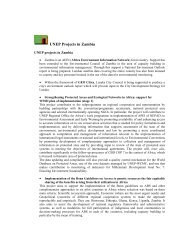
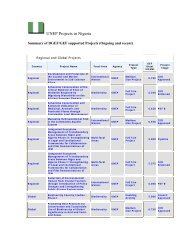
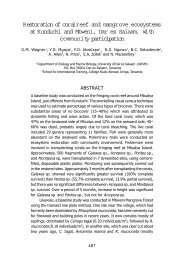
![Please Click to download [English] - GRID Africa GeoPortal - UNEP](https://img.yumpu.com/30633391/1/184x260/please-click-to-download-english-grid-africa-geoportal-unep.jpg?quality=85)
